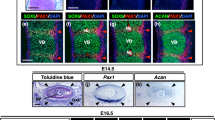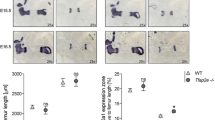ABSTRACT
Aggrecan degradation in osteoarthritis is mediated primarily by aggrecanases (−1 and −2) that are members of the ADAMTS family of proteases. Aggrecanase-2 (ADAMTS-5) null mice are resistant to aggrecan degradation in models of experimentally-induced osteoarthritis. In order to analyze ADAMTS-5 gene expression at the transcriptional level, we have cloned a 2.6 kb promoter region (−2096 to +506) of the human ADAMTS-5 gene and generated βgal reporter constructs. Promoter functionality was tested in transient transfection assays in chondrocytic cells. Analysis of the 2.6 kb promoter sequence indicated four putative binding sites for the Runx family of transcription factors, of which one member, Runx2, plays a role in chondrocyte maturation and hypertrophy. Overexpression of Runx2 stimulated reporter gene expression ∼7-fold over control in SW1353 human chondrosarcoma cells and ∼5-fold over control in primary bovine articular chondrocytes, suggesting ADAMTS-5 to be a potential downstream target of Runx2. 5′-deletions in the promoter resulted in a substantial loss in responsiveness to Runx2 implicating the functional importance of the distal promoter region that harbors putative Runx binding elements for achieving maximal Runx2 effects. The promoter-reporter construct could serve as a useful tool to understand the regulation of ADAMTS-5 gene expression at the transcriptional level.




Similar content being viewed by others
References
Pratta MA, Yao W, Decicco C, Tortorella MD, Liu R-Q, Copeland RA, Magolda R, Newton RC, Trzaskos JM, Arner EC (2003) Aggrecan protects cartilage collagen from proteolytic cleavage. J Biol Chem 278:45539–45545
Arner EC, Pratta MA, Decicco CP, Xue CB, Newton RC, Trzaskos JM, Magolda RL, Tortorella MD (1999) Aggrecanase. A target for the design of inhibitors of cartilage degradation. Ann New York Acad Sci 878:92–107
Lohmander LS, Neame PJ, Sandy JD (1993) The structure of aggrecan fragments in human synovial fluid. Evidence that aggrecanase mediates cartilage degradation in inflammatory joint disease, joint injury, and osteoarthritis. Arth Rheum 36:1214–1222
Tortorella MD, Pratta M, Liu RQ, Austin J, Ross OH, Abbaszade I, Burn T, Arner E (2000) Sites of aggrecan cleavage by recombinant human aggrecanase-1 (ADAMTS-4). J Biol Chem 275:18566–18573
Sandy JD, Thompson V, Doege K, Verscharen C (2000) The intermediates of aggrecanase-dependent cleavage of aggrecan in rat chondrosarcoma cells treated with interleukin-1. Biochem J 351:161–166
Abbaszade I, Liu RQ, Yang F, Rosenfeld SA, Ross OH, Link JR, Ellis DM, Tortorella MD, Pratta MA, Hollis JM, Wynn R, Duke JL, George HJ, Hillman MC Jr, Murphy K, Wiswall BH, Copeland RA, Decicco CP, Bruckner R, Nagase H, Itoh Y, Newton RC, Magolda RL, Trzaskos JM, Burn TC (1999) Cloning and characterization of ADAMTS11, an aggrecanase from the ADAMTS family. J Biol Chem 274:23443–23450
Stanton H, Rogerson F, East C, Golub S, Lawlor K, Meeker C, Little C, Last K, Farmer P, Campbell I, Fourie A, Fosang A (2005) ADAMTS5 is the major aggrecanase in mouse cartilage in vivo and in vitro. Nature 434:648–652
Malfait AM, Liu RQ, Ijiri K, Komiya S, Tortorella MD (2002) Inhibition of ADAM-TS4 and ADAM-TS5 prevents aggrecan degradation in osteoarthritic cartilage. J Biol Chem 277:22201–22208
Glasson SS, Askew R, Sheppard B, Carito BA, Blanchet T, Ma HL, Flannery CR, Kanki K, Wang E, Peluso D, Yang Z, Majumdar MK, Morris E (2004) Characterization of and osteoarthritis susceptibility in ADAMTS-4-knockout mice. Arth Rheum 50:2547–2558
Glasson S, Askew R, Sheppard B, Carito B, Blanchet T, Ma H, Flannery C, Peluso D, Kanki K, Yang Z, Majumdar M, Morris E (2005) Deletion of active ADAMTS5 prevents cartilage degradation in a murine model of osteoarthritis. Nature 434:644–648
Ducy P, Zhang R, Geoffroy V, Ridall AL, Karsenty G (1997) Osf2/Cbfa1: A transcriptional activator of osteoblast differentiation. Cell 89:747–754
Inada M, Yasui T, Nomura S, Miyake S, Deguchi K, Himeno M, Sato M, Yamagiwa H, Kimura T, Yasui N, Ochi T, Endo N, Kitamura Y, Kishimoto T, Komori T (1999) Maturational disturbance of chondrocytes in Cbfa1-deficient mice. Dev Dynam 214:279–290
Takeda S, Bonnamy J-P, Owen MJ, Ducy P, Karsenty G (2001) Continuous expression of Cbfa1 in nonhypertrophic chondrocytes uncovers its ability to induce hypertrophic chondrocyte differentiation and partially rescues Cbfa1-deficient mice. Genes Dev 15:467–481
Ueta C, Iwamoto M, Kanatani N, Yoshida C, Liu Y, Enomoto-Iwamoto M, Ohmori T, Enomoto H, Nakata K, Takada K, Kurisu K, Komori T (2001) Skeletal malformations caused by overexpression of Cbfa1 or its dominant negative form in chondrocytes. J Cell Bio 153:87–99
Zhang MQ (2006) Identification of human gene core promoters in silico. Genome Res 8:319–326
Drissi H, Luc Q, Shakoori R, Chuva De Sousa Lopes S, Choi JY, Terry A, Hu M, Jones S, Neil JC, Lian JB, Stein JL, Van Wijnen AJ, Stein GS (2000) Transcriptional autoregulation of the bone related CBFA1/RUNX2 gene. J Cell Physiol 184:341–350
Craig AM, Denhardt DT (1991) The murine gene encoding secreted phosphoprotein 1 (osteopontin): promoter structure, activity, and induction in vivo by estrogen and progesterone. Gene 100:163–171
Wang X, Manner PA, Horner A, Shum L, Tuan RS, Nuckolls GH (2004) Regulation of MMP-13 expression by RUNX2 and FGF2 in osteoarthritic cartilage. Osteoarthr Cartilage 12:963–973
Sato M, Morii E, Komori T, Kawahata H, Sugimoto M, Terai K, Shimizu H, Yasui T, Ogihara H, Yasui N, Ochi T, Kitamura Y, Ito Y, Nomura S (1998) Transcriptional regulation of osteopontin gene in vivo by PEBP2aA/CBFA1 and ETS1 in the skeletal tissues. Oncogene 17:1517–1525
Jimenez MJG, Balbin M, Lopez JM, Alvarez J, Komori T, Lopez-Otin C (1999) Collagenase 3 is a target of Cbfa1, a transcription factor of the runt gene family involved in bone formation. Mol Cell Biol 19:4431–4442
Ducy P, Karsenty G (1995) Two distinct osteoblast-specific cis-acting elements control expression of a mouse osteocalcin gene. Mol Cell Biol 15:1858–1869
Selvamurugan N, Chou WY, Pearman AT, Pulumati MR, Partridge NC (1998) Parathyroid hormone regulates the rat collagenase-3 promoter in osteoblastic cells through the cooperative interaction of the activator protein-1 site and the runt domain binding sequence. J Biol Chem 273:10647–10657
Farr A, Roman A (1992) A pitfall of using a second plasmid to determine transfection efficiency. Nucleic Acids Res 20:920
Geoffroy V, Ducy P, Karsenty G (1995) A PEBP2a/AML-1-related factor increases osteocalcin promoter activity through its binding to an osteoblast-specific cis-acting element. J Biol Chem 270:30973–30979
Nuchprayoon I, Meyers S, Scott LM, Suzow J, Hiebert S, Friedman AD (1994) PEBP2/CBF, the murine homolog of the human myeloid AML1 and PEBP2 beta/CBF beta proto-oncoproteins, regulates the murine myeloperoxidase and neutrophil elastase genes in immature myeloid cells. Mol Cell Biol 14:5558–5568
Thirunavukkarasu K, Pei Y, Moore TL, Wang H, Yu X-P, Geiser AG, Chandrasekhar S (2006) Regulation of the human ADAMTS-4 promoter by transcription factors and cytokines. Biochem Biophys Res Comm 345:197–204
Author information
Authors and Affiliations
Corresponding author
Rights and permissions
About this article
Cite this article
Thirunavukkarasu, K., Pei, Y. & Wei, T. Characterization of the human ADAMTS-5 (aggrecanase-2) gene promoter. Mol Biol Rep 34, 225–231 (2007). https://doi.org/10.1007/s11033-006-9037-3
Received:
Accepted:
Published:
Issue Date:
DOI: https://doi.org/10.1007/s11033-006-9037-3




